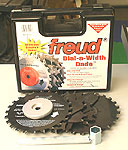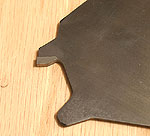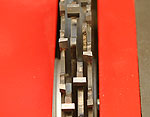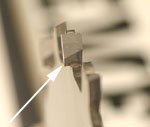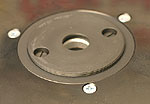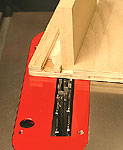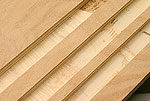This is a Veteran Owned site

Freud's 8" Dial-A-Width DadoImpeccable cuts, super-accurate and no shimsText & Photos by Tom Hintz Posted - 1 27-2005 Safety: Always unplug the saw when working on, around the saw blade! Be safe first! When Freud released the Dial-A-Width Dado, many (me included) thought they had devised a way to incorporate an adjustable wobble blade into a stacked set. Of course, that proved to be incorrect. Freud actually had re-engineered the decades old stacked dado design, making it fully adjustable without having to install shims. The result is a super-accurate stacked dado that is faster and easier to adjust. Wood thickness can vary as it comes from the manufacturer or due to in-shop operations such as planning or sanding. Cutting dados to fit the resulting wood thicknesses has become a frustrating, time-consuming chore for all woodworkers. At least it was before the Freud Dial-A-Width Dado. Initial Impressions
The Freud Dial-A-Width Dado is very well made everywhere you look. The high-strength blade bodies are laser cut and the edges cleanly finished. All of the Freud Dial-A-Width Dado blades have proven anti-kickback features that increase safety considerably. The 5/8"-diameter mounting holes are precisely cut and finished. This is an important factor because it prevents radial distortions of the stack that may cause irregular bottoms in the dado or vibrations. Freud uses a super micrograin carbide and titanium formula that is ground to powder consistency, accurately mixed and then formed into blanks from which the teeth are ground. This powdered metal technology is used extensively in the aerospace industry because it allows precise uniformity of the carbide-titanium content throughout the finished piece. Though obviously an expensive manufacturing process, it yields superior quality saw blade teeth that stay sharp longer. The teeth are bonded to the blade bodies with a special tri-metal brazing that produces a very strong joint without overheating the blade body. Each tooth is finely sharpened with smooth, consistent lands and crisp edges. The Freud Dial-A-Width Dado mechanism also shows precise machining that results in smooth operation and accurate, repeatable adjustments. Instructions
The all-English, multi-page instruction booklet adequately covers all aspects of setting up and using the Freud Dial-A-Width Dado. Because of the unique way the Freud Dial-A-Width Dado works, a special chart is included in the manual that lists the makeup of stacks for ten popular dado widths from ¼" to 13/16"-wide. The chart includes the number of "clicks" that must be dialed in with each stack to achieve the desired width. Those stack thicknesses can be increased or decreased by a maximum of 0.093" using the dial only. Larger stack changes require adding or removing chipper plates. This chart is so important to using the Freud Dial-A-Width Dado, printing it on a separate, durable card the woodworker could keep handy would be a good idea. Tooth DesignThe Freud Dial-A-Width Dado cuts exceptionally clean dados with square sides and flat, smooth bottoms. A combination of tooth designs on the outer blades and chippers makes this cutting performance possible. The outer blades have 24 teeth with a negative 12-degree hook angle. The outer blade teeth alternate between a flat, 0.188"-wide (3/16") tooth followed by a 0.125"-wide (1/8") beveled tooth with 12 of each style per blade. This ATB (Alternate Tooth Bevel) design produces clean, smooth sides that are square to the floor of the dado. The 4-tooth chippers also have a negative 12-degree hook angle but no top bevel. Since the chippers only clear material from between the outer blades, the ATB design is not required. The 3/32"-wide chipper has teeth measuring 0.154"-wide (just under 5/32"). The 1/8"-wide chipper teeth are 0.269"-wide, (a little over 17/64"). These dimensions produce an overlap between the chippers and outer plates that insures a smooth, flat bottom surface in the dado. This overlap is also part of how the Freud Dial-A-Width Dado works. Special HubsThe 24-tooth outer blades have specially-designed hubs fitted at their centers that must be oriented correctly in relation to the arbor. The instructions show how to swap the hubs from one outer blade to the other to accommodate both left and right side arbors. The inner blade hub has a recess that accepts the arbor cup washer. The outer blade holds the adjuster mechanism that also has a recess to accept blade retaining nuts up to 1 3/16" in diameter.
A special offset 7/8" socket wrench is included in the Freud Dial-A-Width Dado kit. If your blade nut is a different size, an appropriately sized, standard length socket works just as well. How the Dial-A-Width Dado WorksThe adjuster mechanism is essentially a short, wide bolt with fine threads that engage a threaded bushing in the outer blade body. The adjuster dial has internal spring loaded detent balls that produce a "click" signaling each 0.004" of change. By starting with the adjuster flush with the inside face of the blade, the user can precisely increase the width of the dado stack. The 0.188"-wide teeth on the outer blades are offset towards the inside of the dado stack, overlapping the 0.269"-wide chipper teeth. When the adjuster dial is turned it spaces the outer blade further from the chipper, increasing the effective width of the dado the stack. The overlapping teeth insure a full, clean cut at the bottom of the dado throughout the maximum 0.028" adjustment range. The result is an infinitely adjustable stacked dado set that is more versatile than traditional shim-based dado blade designs. Eliminating shims also makes adjusting the Freud Dial-A-Width Dado much faster with no sacrifice in the quality of the dado it cuts. Will the Dial-A-Width Dado Fit My Saw?While the Freud Dial-A-Width Dado design uses arbor length efficiently, it will not fit every saw. As always, follow the saw manufacturers recommendations on the maximum dado width and diameter. Freud's website says to measure the arbor length from the inner flange (the surface that contacts the blade) and then subtract the width of the nut. If the remaining dimension is at least 1 3/32", you can install the Freud Dial-A-Width Dado stack up to ¾"-wide. If the remaining dimension is at least 1 3/16" the entire set of chippers can be installed between the outer blades to produce the maximum 13/16"-wide stack. The inner blade has a recess in its hub that will accept flange washers up to a maximum of 2 ½"-diameter. If the inner washer on your saw is larger, do not modify it! You may have to use another Freud stacked dado set.
In The ShopNote: This evaluation is based on the 8" (SD608) Dial-A-Width Dado. Freud also offers a 6"-diameter (SD606) version of the Dial-A-Width Dado. As is our practice, the alignment of the saw (Delta 36-682 Industrial Contractor Saw) used to test the Freud Dial-A-Width Dado was checked prior to beginning the evaluation. The blade measured within 0.001" of parallel to the miter slot and the fence was tailed out at the rear, also just under 0.001". To begin testing the Freud Dial-A-Width Dado was configured in all 10 widths listed in the chart. In each case, the dados cut by the Freud Dial-A-Width Dado were 0.0015" wider than specified on the chart. Considering the small alignment error in the saw, it is safe to say the Freud Dial-A-Width Dado cuts near perfect-width dados. Late in testing, the Freud Dial-A-Width Dado was returned to custom width settings we developed and fresh dados cut. The test pieces fit the dados exactly as they did in the first cuts made at those widths. This shows that the Freud Dial-A-Width Dado repeats setups very well. If you record settings for special thickness wood, you can repeat that setup with confidence later. Using the Freud Dial-A-Width Dado is very simple. The chart in the manual shows the combination of chippers needed within the outer blades and the number of "clicks" to be dialed in to cut those common-width dados. The stack is assembled like any other dado set, alternating the blade positions so the teeth do not contact each other. When adjustments of the stack width are needed, loosen the nut, dial in the number of clicks needed and re tighten the nut. If an accurate tool is used to measure the stock and test dado cut, dialing in the perfect adjustment is very easy. Keep in mind that each click of the adjuster knob produces 0.004" of change. The knob can also be positioned between clicks for even finer adjustments. The real beauty of the Freud Dial-A-Width Dado is cutting dados for stock that has been planed or sanded to an uncommon thickness. It was easy to assemble the stack to the closest thickness in the chart and then adjust the specified number of clicks to hit the new width. Making more than two test cuts to perfect the dado width was rare. The Freud Dial-A-Width Dado made very clean dados in everything from simple pine to solid oak and the always-fragile oak veneer plywood. Square sides, flat, clean bottoms and chip-free edges were the norm. The Freud Dial-A-Width Dado, mounted on a sufficiently long arbor, has a maximum stack width range of ¼" to 29/32". With a standard Delta cast metal dado insert installed in the Delta #36-682 contractor saw used to test the Freud Dial-A-Width Dado, the maximum height possible was 1 13/16". That is more than sufficient to half-lap common 4X4 (3 ½ by 3 ½") stock. A non-metallic insert could be recessed to increase the maximum height but the actual gain will be small. Dados deeper than " are very rare in the home woodworking shop. Conclusions With a street price of $259.99 (1-26-2005) the 8" Freud Dial-A-Width Dado (SD608) is an investment that will make cutting dados a faster, more accurate task for many years to come. Visit the Freud Tools web site! Do you have a comment about this page? - Email Me!
|
All written, photographic and drawn materials are property of and copyright by NewWoodworker.com LLC 2000-2019. Materials may not be used in any way without the written permission of the owner.

